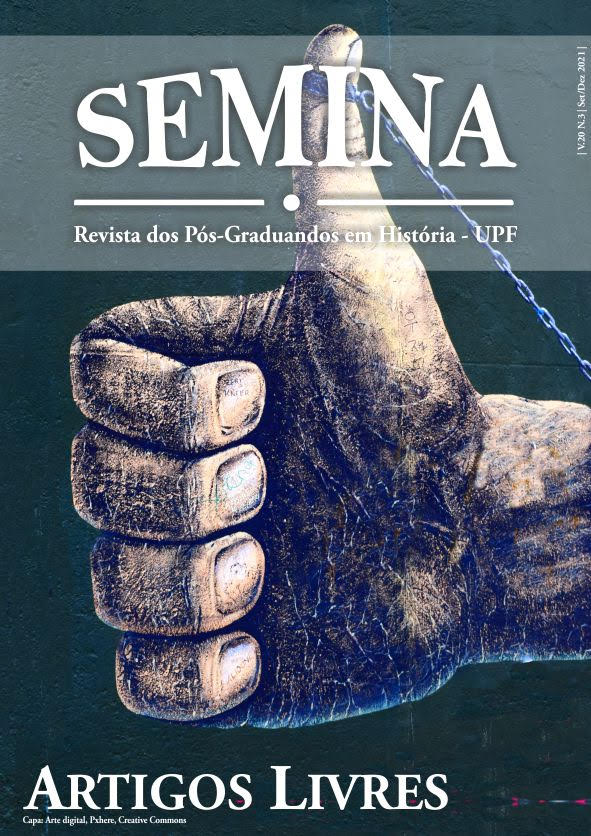Historical reinterpretations in representations and re(a)presentations in “Bacurau"
DOI:
https://doi.org/10.5335/srph.v20i3.13103Keywords:
Cinema, Northeast, Imagistic ReconstructionsAbstract
This article discusses the historical resignifications in the film “Bacurau” (2019). Thus, critical-theoretical concepts such as representation, based on Hall (2006) and Chartier (2002) in the context of Cultural Studies and Cultural History, as well as ideas of power and distinction in Bourdieu (1989), are used, in order to understand the agency and spatial significations in the diegesis. Furthermore, the filmic language is taken as a locus of positioning that starts from the authors and the world that surrounds them, in addition to those who receive the work; the moving-images that are approached as readable texts, as writing in images. In the end, it is understood that the artistic work brings elements that engender anti-colonial narratives to socially and historically subaltern people.
Downloads
References
BARROS, José D’Assunção. A história cultural e a contribuição de Roger Chartier. Diálogos, DHI/PPH/UEM, v. 9, n. 1, p. 125-141, 2005.
BARROS, José D’Assunção. Cinema e história: considerações sobre os usos historiográficos das fontes fílmicas. Ano 32, n. 55, p. 175-202, jan./jun. 2011.
BHABHA, Homi K. O local da cultura. Tradução: Myriam Ávila, Eliana Lourenço de Lima Reis, Gláucia Renate Gonçalves; Belo Horizonte, Editora: UFMG, 1998.
BOURDIEU, Pierre. O poder simbólico. Rio de Janeiro: Difel, 1989.
BURKE, Peter. O que é história cultural? Rio de Janeiro: Jorge Zahar Ed., 2005
BUTLER, Judith. Precarious life: the powers of mourning and violence. New York: Verso, 2004.
CANCLINI, Nestor Garcia. Quem fala e em qual lugar. In: _____. CANCLINI, Nestor Garcia. Diferentes, desiguais e desconectados: mapas da interculturalidade. Tradução de Luís Sérgio Henriques. Rio de Janeiro: Ed. UFRJ, 2005.
CERTEAU, Michel. A cultura no plural. Campinas, SP: Papirus, 1995.
CHARTIER, Roger. A história cultural: entre práticas e representações. 2º edição, Portugal: DIFEL, 2002.
CUNHA, Euclides da. Os Sertões. São Paulo: Três, 1984 [Original de 1902]. (Biblioteca do Estudante).
DAMÁSIO, K. L.; BORÓ, S. Pode o subalterno ser representado? PROA Revista De Antropologia e Arte, 2(9), 221-239, 2019.
FOUCAULT, Michel. Genelogía del racismo. La Plata, Argentina: Editora Altamira, 1998.
HALL, Stuart. A identidade cultural na pós-modernidade. 11. ed. Rio de Janeiro: DP&A, 2006.
HALL, Stuart. Cultura e representação. Rio de Janeiro: Ed. PUC-Rio: Apicuri, 2016.
HAN, Byung-Chul. Topologia da violência. Petrópolis, RJ: Vozes, 2017
KAFKA, Franz. Aforismos reunidos. Introdução e tradução de Modesto Carone. São Paulo: Instituto Moreira Salles, 2012.
LINS, Paula Diniz. O pobre em cena: representação no cinema brasileiro contemporâneo. 2009. 126 f. Dissertação (Mestrado em Literatura), Universidade de Brasília, Brasília, 2009.
MBEMBE, Achille. Necropolítica: biopoder, soberania, estado de exceção, política de morte. São Paulo: n-1 edições, 2018.
MOTTA, Márcia Maria Menéndez. História e memória. Revista Cadernos do Ceom, v. 16, n. 17, p. 179-200, 2003.
ORLANDI, Eni Puccinelli. Análise de discurso: princípios & procedimentos. 8. ed. Campinas: Pontes, 2009.
PEIRCE, Charles Sanders. Semiótica. São Paulo: Perspectiva, 2005.
PRYSTHON, Angela. O subalterno na tela: um novo cânone para o cinema brasileiro. Texto apresentado na XIII COMPÓS-Associação Nacional dos Programas de Pós-Graduação em Comunicação. São Bernardo do Campo/São Paulo, 2004.
SANTOS, Milton. A Natureza do Espaço: Técnica e Tempo, Razão e Emoção. 4. ed. 2. reimpr. São Paulo: Editora da Universidade de São Paulo, 2006.
SCHWARCZ, Lilia Moritz; STARLING, Heloisa Maria Murgel. Brasil: uma biografia, 2015.
SPIVAK, Gayatri. Pode o subalterno falar? Belo Horizonte: Editora UFMG, 2010.
SPYER, Tereza. Distopias à brasileira: ‘Bacurau’ e ‘Divino Amor’. Epistemologias do Sul, v. 3, n. 1, p. 92-109, 2019.
VALENCIA, Sayak; SEPÚLVEDA, Katia. Del fascinante fascismo a la fascinante violencia: Psico/bio/necro/política y mercado gore. Mitologías hoy, [en línea], Vol. 14, pp. 75-91, 2016.
ŽIŽEK, Slavoj. Violência: seis reflexões laterais. 1. ed. São Paulo: Boitempo, 2014.
Filmografia
BACURAU (Brasil/França, 2019). Direção: Kleber Mendonça Filho; Juliano Dornelles: Vitrines Filmes, 131 min.
Downloads
Published
Issue
Section
License
Autores que publicam nesta revista concordam com os seguintes termos:
- Autores mantêm os direitos autorais e concedem à revista o direito de primeira publicação, com o trabalho simultaneamente licenciado sob a Licença Creative Commons Atribuição 4.0 Internacional – CC-BY que permitindo o compartilhamento do trabalho com reconhecimento da autoria do trabalho e publicação inicial nesta revista.
- Autores têm autorização para assumir contratos adicionais separadamente, para distribuição não-exclusiva da versão do trabalho publicada nesta revista (ex.: publicar em repositório institucional ou como capítulo de livro), com reconhecimento de autoria e publicação inicial nesta revista.
- Autores têm permissão e são estimulados a publicar e distribuir seu trabalho online (ex.: em repositórios institucionais ou na sua página pessoal), a qualquer ponto antes ou durante o processo editorial, já que isso pode gerar alterações produtivas, bem como aumentar o impacto e a citação do trabalho publicado, de acordo ainda com a democratização científica prevista pela Ciência Aberta.





